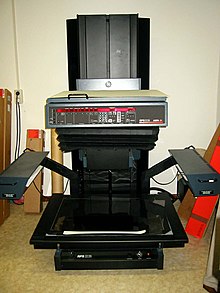Repro photography
The reprophotography ( Reproduction Photography ) is a method of reproduction technology . On the one hand, it is a sub-area of reprography , on the other hand, that branch of photography that deals with the faithful reproduction of two-dimensional templates (book pages, paintings, engravings, etc.). It encompasses some of the methods that enable the technical reproducibility of these templates.
The reproduction photography pays particular attention to the true-to-original color and contrast reproduction of the original . In the past it was mainly used in prepress.
equipment
Reprophotography is a domain of the single -lens reflex camera (both small and medium format ) and the large format camera , at the same time as the respective standard lens or macro lenses with standard focal length (corresponding to the millimeters of the image diagonal ). In certain cases, shift lenses are also used with SLRs . In any case, the lens should always be stopped down by at least two f-stops. Professional repro photography uses special repro cameras made for this purpose (e.g. two-room cameras ). They are used to reproduce maps or other large format templates.
Essential for professional repro photography is a tripod , the possibility of light measurement (or substitute measurement with gray card ) and usually also a studio flash system with polarization filters . Usually the sharpest films or the lowest sensitivity setting for a digital camera are used here.
If the (color) photos are to be printed later, a color table that was also photographed is an advantage.
For originals that do not exceed the A2 format, it is recommended to use a copy stand that takes pictures of the object from above .
Usually the photographer will use an angle or light shaft finder . An autofocus helps with focusing for fatigue-free work .
Recording technology in general
In general, for every two-dimensional template that is to be reproduced,
- the optical axis must be in the center of the object,
- the film plane must be aligned absolutely parallel to the object plane .
As a rule, images to be reproduced are rectangular (otherwise one "thinks" of a rectangle spanning the object), so that the image center is simply described by the intersection of the diagonals of the image. For this purpose, it is sufficient, for example, to stretch two twine from the diagonally opposite corners of the object.
Once the center of the picture has been determined, hold a small mirror ( pocket mirror ) at this point . Now align the camera in such a way that the lens is mirrored in a circular shape with its front lens when you look through the reflex viewfinder . In this case the image and film planes are parallel.
Studio flash system as a light source
If a picture is to be taken with artificial light (typically a studio flash system), at least two light sources of the same luminosity are required, each positioned on both sides of the object at a 45 ° angle. Four are better, so one at each corner. In the case of reflective surfaces such as an oil painting, the light sources must be provided with polarizing filters , whereby it must be ensured that these must be aligned alternately horizontally and vertically.
Daylight as a light source
If there is no studio flash system and the like available, you have to make sure that no direct light source shines on the object with reflective surfaces (oil paintings).
A tried and tested trick is to take pictures against the light on a wall in the shade in a bright room. Windows should let in direct sunlight but be draped with white curtains or sheets. However, these natural light sources must not be too close to the optical axis or even in the final image itself.
The use of a lens hood and a high-contrast film is recommended .
literature
- Detlef Jürgen Brauner, Robert Raible-Beste, Martin M. Weigert, Multimedia-Lexikon , p. 290, ISBN 3486794922
- Reinhard Welz, Lexikon der Reprotechnik , 2007, ISBN 3866565364
- Roland Golpon, Reproduction Photography - Textbook of the Printing Industry , ISBN 3876411793

